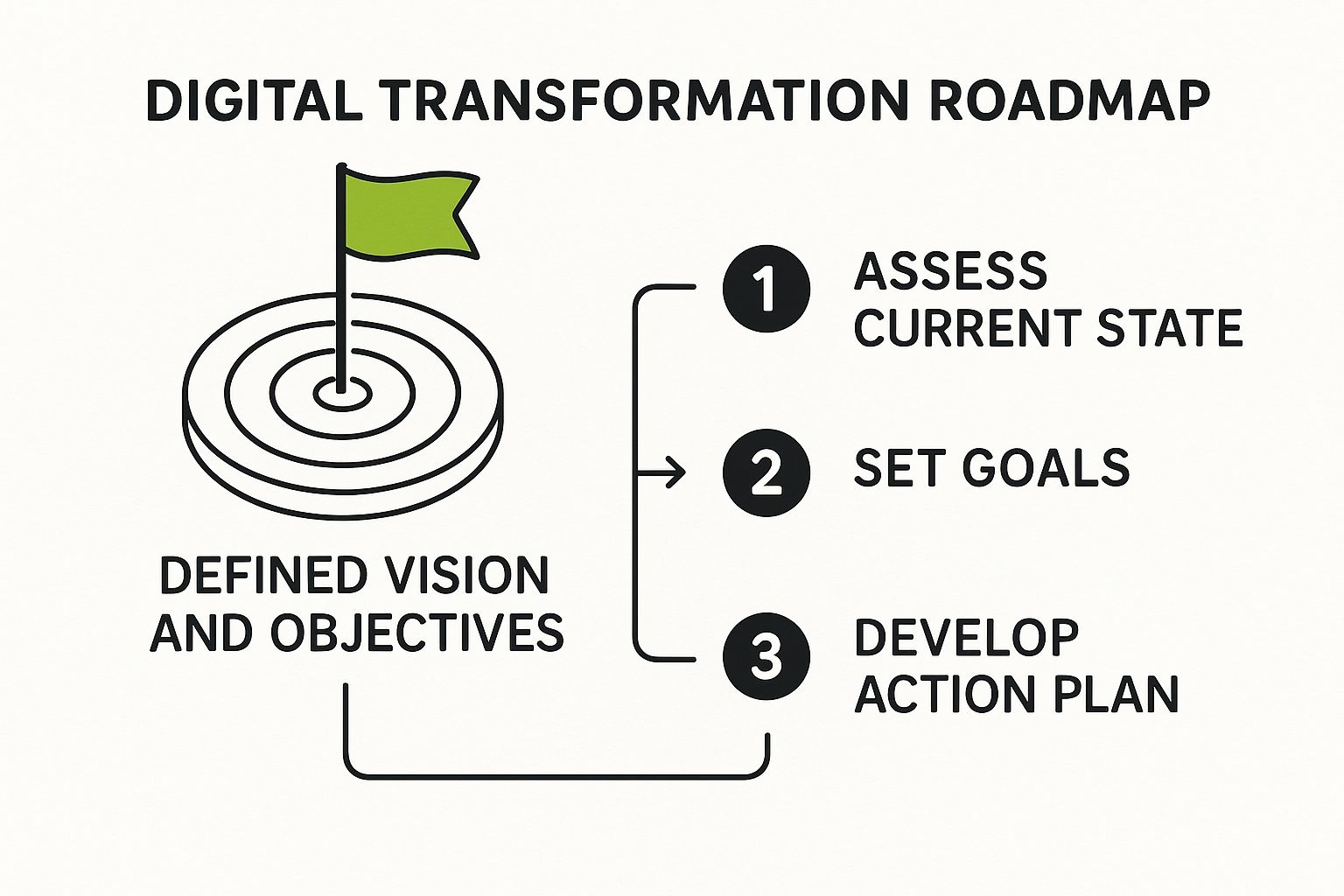Think of a “digital transformation roadmap” less as a stuffy corporate document and more as your strategic playbook for survival and growth. It’s the bridge that connects where your business is today to where it needs to be tomorrow. This plan is absolutely essential for making sure your tech investments actually push the business forward, instead of just becoming another line item on a budget.
Why Your Business Needs This Roadmap Now

Let’s cut through the buzzwords. A digital transformation roadmap isn’t an IT department’s wish list or a catalog of trendy software to buy. I’ve seen too many companies make that mistake.
Without a clear plan, “transformation” efforts become a mess of fragmented, expensive projects that go nowhere. You end up with powerful tools nobody uses or automated processes that solve the wrong problems. A solid roadmap prevents this chaos by tying every single action back to a specific, measurable business goal.
The Urgency is Real
The pressure to evolve isn’t some distant threat—it’s right here, right now. Nimble competitors, free from clunky legacy systems, can swoop in and steal customers with better digital experiences. At the same time, your customers’ expectations have completely changed. They demand seamless, personal, and instant service, a standard set by digital-first companies.
In this environment, standing still is the biggest risk you can take.
The data backs this up. By 2025, a staggering 94% of organizations are expected to have digital initiatives underway. It’s not a niche activity anymore; 32% of managers see it as a basic requirement for survival. If you’re curious about the numbers, Veritis.com offers more insights into digital transformation trends.
Here’s a common pitfall I see all the time: treating digital transformation as a one-and-done project. It’s not. It’s a continuous evolution, and your roadmap should be a living document that adapts to new challenges and opportunities.
It’s About More Than Just Technology
A successful roadmap isn’t just about bolting on new tech. It’s about making strategic improvements in key areas that deliver real, tangible value. Before we dive into the “how,” let’s get a clear picture of what we’re building.
The table below summarizes the core components we’ll be breaking down. Think of it as a high-level overview of the journey ahead.
| Pillar | Key Focus | Business Outcome |
|---|---|---|
| Operational Efficiency | Automating repetitive tasks and streamlining workflows. | Reduced errors, lower costs, and a more productive team. |
| Customer Engagement | Creating smoother, more personalized customer journeys. | Increased loyalty, higher satisfaction, and better retention. |
| Core Systems | Updating foundational technology to support growth. | Greater agility, improved security, and future-ready operations. |
Ultimately, a good roadmap focuses on these pillars to deliver concrete results. It’s about building a stronger, more competitive business from the inside out, ensuring every dollar you spend on technology turns into measurable success.
Before you even think about buying new software or hiring a single developer, the most important work of your digital transformation has to happen. This isn’t about servers or code; it’s about getting the right people in a room and figuring out your “why.” This is the strategic foundation, and skipping it is the fastest way to waste a lot of time and money.
A successful transformation is built on a crystal-clear, shared understanding of your goals. You need to get your key leaders together—from the C-suite to the managers on the front lines—and ask some tough questions. What specific business problems are we actually trying to fix? What does a “win” look like in three years?
Without this alignment, you’ll end up with a mess. Different departments will pull in opposite directions, creating a patchwork of disconnected tools instead of a unified, powerful strategy.
Get Your A-Team in Place
First things first: you need to assemble a cross-functional transformation team. This can’t be some sleepy steering committee that meets once a quarter. This group needs real authority to make decisions and drive change.
Your team should be a mix of people who can speak for every part of the business:
- Executive Leadership: You need a champion to provide the vision, secure the budget, and keep the momentum going.
- IT and Technology: These are the folks who will assess technical feasibility and what your infrastructure can handle.
- Operations: They bring a dose of reality, grounding the strategy in the day-to-day work that actually gets done.
- Marketing and Sales: They represent the voice of your customer and keep everyone focused on revenue goals.
- Human Resources: Don’t forget the people! HR is critical for managing the change, including training and communication.
Having this mix of perspectives ensures your roadmap isn’t built in an echo chamber. It becomes a plan the entire organization can get behind because they had a hand in creating it. The potential here is massive; the global digital transformation market is expected to explode from USD 1.42 trillion in 2025 to USD 13.26 trillion by 2035. You can discover more insights from the 2025-2035 market forecast report to see why this foundational work matters.
Define What Success Actually Looks Like
With your team assembled, it’s time to define success with sharp, meaningful KPIs. So many companies fall into the trap of focusing only on cutting costs. While that’s a piece of the puzzle, real transformation creates value across the entire business.
I’ve seen this happen countless times: companies chase technology for technology’s sake. The goal isn’t to be “more digital.” The goal is to solve a business problem. Your KPIs must reflect the problems you’re trying to solve.
Ditch the generic, fluffy goals and get specific with metrics that truly move the needle.
| KPI Category | Weak KPI Example | Strong KPI Example |
|---|---|---|
| Customer Impact | Increase website traffic | Boost customer lifetime value (CLV) by 15% |
| Operational Impact | Implement new software | Reduce order fulfillment time by 25% |
| Employee Impact | Conduct training sessions | Improve employee productivity scores by 20% |
See the difference? These stronger KPIs force you to connect every tech investment to a real business outcome. A higher CLV isn’t just a number; it’s the direct result of a better customer experience, which should be at the heart of any digital transformation.
Let’s Talk Real-World: A Retail Scenario
Let’s bring this down to earth. I once worked with a mid-sized retailer whose online and in-store experiences were completely disconnected. It was a mess. In their foundational meetings, one major pain point surfaced: the returns process was a nightmare for customers. You couldn’t easily return an online purchase in-store, and vice versa. This led to frustrated customers and, you guessed it, lost sales.
The team didn’t just jump to buying a new point-of-sale system. Instead, they set a clear, foundational goal that became their North Star: “Create a unified, hassle-free returns process across all channels within 12 months.”
This simple but powerful objective immediately clarified their priorities:
- Integrate Inventory Systems: They had to get a single view of their stock, whether it was in a warehouse or a back storeroom.
- Rethink In-Store Processes: Staff needed new tools and training to handle online returns without a headache.
- Update the E-commerce Platform: The website had to clearly communicate the new, super-flexible return options.
By starting with a specific, customer-focused problem, they built a strategy that made sense. Every decision that followed—from the tech they chose to the training they rolled out—was measured against that one core goal. That’s the power of building your roadmap on a rock-solid strategic foundation.
Mapping Your Journey From Now to Next
Okay, you’ve got your strategic foundation. Now for the fun part: turning that big-picture vision into a plan you can actually execute. This is where we build your digital transformation roadmap, moving from those high-level goals to concrete, scheduled projects.
Think of this roadmap as a living document. It’s meant to guide your decisions, not be a rigid blueprint that shatters the first time something unexpected happens.
The first move is a brutally honest gap analysis. You need a clear-eyed look at where you are today versus where you want to be. Where are the biggest disconnects? This isn’t about pointing fingers or finding fault; it’s about pinpointing the most fertile ground for meaningful change.

This visual really gets to the heart of it. Your roadmap is the deliberate path you construct to bridge the gap between your current reality and your future ambitions.
Break It Down Into Phases
One of the biggest mistakes I see companies make is trying to do everything at once. It’s a “boil the ocean” approach that almost always ends in blown budgets, a burnt-out team, and ultimately, failure.
A much smarter way is to break the journey into manageable, sequential phases. Each phase should deliver tangible value on its own and build momentum for whatever comes next.
For example, a growing e-commerce business might phase its transformation like this:
- Phase 1 – Foundational Customer Data: First, get a grip on your customer data. This means digitizing core service channels and implementing a CRM. The goal is a single, unified view of every customer interaction.
- Phase 2 – Operational Excellence: With customer data flowing, you can now focus on efficiency. Automate inventory management and order fulfillment to cut down on manual errors and speed up shipping.
- Phase 3 – Personalization at Scale: Finally, use the rich data from Phase 1 and the new efficiencies from Phase 2 to launch personalized marketing campaigns and on-site product recommendations.
See how each step logically builds on the last? This creates a rock-solid foundation for more advanced capabilities later on. If you’re looking for the right systems for these phases, our guide on essential e-commerce tools and platforms is a great place to start your research.
Prioritize With an Impact vs. Effort Matrix
So you’ve got a list of potential projects. How do you decide what to tackle first? My go-to tool for this is simple but incredibly powerful: the impact versus effort matrix. It helps you get past gut feelings and make truly strategic prioritization decisions.
Just plot each initiative on a four-quadrant grid:
- High Impact, Low Effort (Quick Wins): Do these first. They deliver major value without draining your resources and create that all-important early momentum.
- High Impact, High Effort (Major Projects): These are your big, strategic game-changers. They require serious planning and investment but are absolutely critical for long-term success.
- Low Impact, Low Effort (Fill-ins): Tackle these only when you have spare capacity. Don’t let them distract you from the more important stuff.
- Low Impact, High Effort (Thankless Tasks): Avoid these like the plague. They burn time and money for almost no return.
This simple exercise forces your team to have tough, necessary conversations about the true value and real cost of each project. It ensures you’re putting your energy where it will make the biggest difference.
Remember, the whole point of a digital transformation roadmap is to drive business outcomes. By prioritizing high-impact initiatives, you ensure your early efforts show a clear ROI. This is absolutely crucial for keeping your executives bought in and your team motivated.
With your projects prioritized and sorted into phases, you can finally build a realistic timeline. Assign clear ownership for every single initiative and define specific, measurable milestones.
A milestone isn’t “Improve customer service.” It’s “Launch the new support chatbot on the website by the end of Q2.” These concrete checkpoints make progress impossible to ignore and keep everyone accountable, turning your strategic map into a practical guide for your journey from now to next.
Choosing the Right Technology and Partners
So, you’ve got your priorities mapped out. Now for the exciting part: picking the tools and allies that will actually bring your digital transformation roadmap to life.
This stage isn’t about chasing the shiniest new toy. It’s about making smart, strategic decisions that directly support the business goals you’ve already laid out. Think of it this way: the right technology stack empowers your strategy; the wrong one will end up dictating it.
It’s easy to get fixated on the sticker price of a new platform, but I’ve seen that mistake sink more than a few projects. The real number you need to focus on is the Total Cost of Ownership (TCO). This goes way beyond the initial purchase to include implementation fees, employee training, ongoing maintenance, and the costs of integrating it with everything else.
Evaluating Your Technology Options
As you start assessing software or platforms, run every single option through a simple but crucial filter.
First, is it scalable? You need something that can grow with your business without forcing you to rip everything out and start over in two years. Second, can it play nicely with your existing systems? A slick new tool that creates data silos is a step backward, not a step forward.
Imagine a mid-sized retailer looking to upgrade their e-commerce game. A cheap, standalone platform might look like a bargain at first. But if it can’t talk to their inventory management or CRM, the manual data entry required will quickly demolish any initial cost savings. Worse, it creates a nightmare experience for both staff and customers.
The most expensive piece of technology is always the one your team refuses to use. Prioritize user experience and ease of adoption above all else. If a tool is clunky or confusing, no amount of fancy features will make up for the fact that nobody wants to log in.
The Great Debate: Build vs. Buy
One of the biggest forks in the road you’ll face is whether to build a custom solution from scratch or buy something off the shelf. There’s no universal “right” answer here. The best choice is completely dependent on your specific needs, your team’s resources, and your long-term vision.
Laying out the options side-by-side can really clarify which path makes sense for a particular initiative.
Comparing Technology Sourcing Strategies
Choosing how to source your technology is a major decision point. This table breaks down the three main paths—building custom, buying off-the-shelf, or a hybrid approach—to help you see which one aligns best with your project’s goals, budget, and timeline.
| Strategy | Best For | Pros | Cons |
|---|---|---|---|
| Buy (Off-the-Shelf) | Standard business functions like HR, accounting, or CRM where you don’t need to reinvent the wheel. | Faster implementation, lower upfront cost, comes with built-in support and regular updates. | Limited customization, you might pay for features you don’t need, risk of vendor lock-in. |
| Build (Custom) | Unique business processes that give you a core competitive advantage and can’t be replicated by a standard tool. | Perfectly tailored to your exact needs, gives you total control over features and future development. | High initial cost, much longer development timeline, you’re responsible for all ongoing maintenance. |
| Hybrid (Mix & Match) | Leveraging the best of both worlds—using a standard platform for its core strengths while building custom pieces for unique needs. | Cost-effective, speeds up deployment, allows for targeted innovation where it matters most. | Requires careful planning to ensure seamless integration, can create some management complexity. |
A hybrid approach is often the sweet spot. For instance, you might buy a market-leading CRM platform but then build a custom integration to connect it to your proprietary manufacturing software. If you’re leaning toward building, it’s worth exploring the nuances of working with external teams. You can get some great insights from this guide on the pros and cons of outsourcing software development to help shape your strategy.
Ultimately, this isn’t just about code; it’s about finding the most effective way to solve a business problem.
Selecting Strategic Partners, Not Just Vendors
The final piece of this puzzle is picking the right people to work with. There’s a huge difference between a vendor and a partner. A vendor sells you a product. A true strategic partner, on the other hand, acts like an extension of your own team, bringing deep industry expertise and a genuine investment in your success.
When you’re vetting potential partners, you need to look past the slick sales pitch.
- Ask for case studies, but get specific. You want to see work they’ve done in your industry. Do they actually understand your unique challenges?
- Talk to their current clients. Don’t just take their word for it. Ask for references and find out if they are responsive, helpful, and proactive problem-solvers.
- Drill down on their support model. What happens after the project goes live? What does their ongoing support and training look like?
A great partner doesn’t just hand you the keys and walk away; they stick around to help you learn how to drive. They offer guidance, share best practices, and work alongside you to make sure the technology actually delivers on its promise. This collaborative relationship is often the single biggest factor in whether a new system fuels real growth or just ends up gathering digital dust.
Putting Your Roadmap Into Action and Sparking Change
A beautifully designed digital transformation roadmap is completely worthless if it just sits on a server gathering digital dust. The plan is only the starting point. What truly separates successful transformations from expensive failures is creating real, tangible momentum. This is where your strategy document turns into progress your team can see, feel, and actually get behind.

The sheer scale of a multi-year transformation can feel paralyzing. So, instead of trying to boil the ocean, think like a software developer and adopt an agile mindset. Break down your massive projects into smaller, manageable “sprints”—these are short, focused work cycles, usually lasting one to four weeks.
This approach lets you deliver value incrementally. At the end of each sprint, you have a tangible improvement, whether it’s a new feature on your website or a freshly automated report. It’s a game-changer because you can gather immediate feedback, adapt your plan based on what’s actually happening, and avoid costly detours without derailing the entire project.
The Human Side of Transformation
Honestly, the technology is the easy part. The real challenge—and where a staggering 70% of transformations fail—is the people. You aren’t just installing new software; you’re fundamentally changing how people do their jobs. If you don’t master change management, you’re setting yourself up for failure. It’s non-negotiable.
Success really boils down to getting your team to move from “the way we’ve always done it” to embracing new possibilities. This takes a deliberate, empathetic, and persistent communication strategy.
- Communicate the ‘Why’ Relentlessly: Don’t just announce what is changing. You have to constantly explain why it’s changing and, most importantly, what’s in it for them. Frame it around making their work less frustrating and more impactful.
- Find Your ‘Change Champions’: In every company, there are influential and respected employees. Identify them and bring them into the fold as advocates. A recommendation from a trusted peer is often far more powerful than any top-down directive.
- Establish Feedback Loops: Create safe, open channels for employees to voice concerns, ask questions, and share ideas. This simple step makes them feel like active participants rather than just being told what to do.
Training That Actually Sticks
Running a single, one-off training session on a new tool and calling it a day is a classic recipe for low adoption. I’ve seen it happen time and again. Effective training needs to be an ongoing process designed to build confidence, not just check a box on a project plan.
Forget the generic slideshows. Focus on hands-on, role-specific workshops. Show your sales team exactly how the new CRM will help them track leads more effectively. Let the operations team get their hands dirty with the new productivity automation tools that will eliminate their most tedious tasks.
The real goal of training isn’t just to teach features; it’s to build conviction. When an employee genuinely believes a new tool will make their job better, adoption becomes a pull, not a push.
Governance and Celebrating Progress
To keep your digital transformation on track, you need a simple governance framework. This isn’t about creating soul-crushing bureaucracy; it’s about maintaining visibility and accountability. Regular, brief check-in meetings are perfect for monitoring progress against your KPIs, spotting risks before they blow up, and ensuring the project stays on budget.
This framework is also your secret weapon for celebrating small wins. Did a team successfully automate a weekly report, saving five hours of manual drudgery? Acknowledge it publicly. Did the new customer service chatbot handle its first 100 queries without a hitch? Celebrate it!
These small victories build a powerful story of progress. They prove to the entire organization that the change is real, positive, and worth all the effort. This is the momentum that turns a one-time project into an enduring culture of continuous improvement—a critical driver in today’s business world.
The scale of this global push is immense. In 2024, spending on digital transformation is projected to reach $2.5 trillion, with a forecast to hit a massive $3.9 trillion by 2027. The United States is a major force here, accounting for 35.8% of this spending. These numbers really underscore why getting the execution right is so critical.
Answering Your Key Roadmap Questions
Even the most buttoned-up digital transformation roadmap is going to stir up questions. That’s a good thing. When you’re tackling something this big, you and your team are bound to hit some gray areas and a few hurdles.
Let’s cut through the noise and get straight to the practical answers you need. My goal here isn’t to talk theory; it’s to give you the real-world clarity to keep things moving forward with confidence.
How Long Should Our Digital Transformation Roadmap Be?
I’ve seen plans that stretch out for five years and some that are hyper-focused on just one. In my experience, a three-year horizon is the strategic sweet spot. It’s long enough to aim for and achieve real, substantial change, but short enough that it doesn’t become totally irrelevant in a market that shifts on a dime.
The real trick is in how you structure it. The first 12 months need to be mapped out in incredible detail—think specific projects, clear deadlines, and assigned owners. For years two and three, you can afford to be a bit broader, focusing on directional goals rather than granular tasks.
It’s a lot like planning a cross-country road trip. You know your final destination (the three-year vision), and you have a precise, turn-by-turn plan for today’s drive (year one). But you’re also ready to take a scenic detour if you hear about a better route along the way (adapting in years two and three).
What Are the Most Common Mistakes We Should Avoid?
Honestly, the biggest tripwires are almost always about people and processes, not the tech. I’ve seen more promising initiatives stall for these same few reasons than I can count.
- Ignoring the Culture: You can’t just drop a new piece of software on a team and expect magic. A new tool is useless if the old mindset and clunky processes stick around.
- No Executive Sponsorship: If you don’t have a visible, vocal champion in the C-suite, your initiative will eventually get starved of resources and authority. It’s a slow, painful death.
- Poor Communication: Failing to constantly, and I mean constantly, explain the “why” behind the changes. When people don’t understand the purpose, fear and resistance are the natural result.
- Measuring the Wrong Things: Chasing quick cost savings is tempting, but it’s shortsighted. The real wins are in long-term gains like better customer loyalty and higher employee morale.
Your digital transformation roadmap has to tackle these human factors head-on from day one. They aren’t secondary—they’re the whole ballgame.
How Do We Measure the True ROI of This Transformation?
Thinking about Return on Investment (ROI) as just a cost-versus-savings formula is a massive mistake. To get the full story of the value you’re creating, you need a balanced scorecard.
Yes, you have to track the financial side of things. But to really justify the long-term investment and prove the deep impact, you need to be measuring success across these key areas:
| Metric Category | Key Performance Indicators (KPIs) to Track |
|---|---|
| Operational Metrics | Faster project cycle times, reduced error rates, increased process automation. |
| Customer Metrics | Higher Net Promoter Score (NPS), improved customer retention rates, increased customer lifetime value (CLV). |
| Employee Metrics | Better employee engagement scores, lower staff turnover, increased productivity per employee. |
This holistic view connects the dots between your transformation work and a healthier, more profitable business from every angle.
How Can We Get Our Team to Embrace These Changes?
Here’s a hard truth: you don’t command buy-in, you have to earn it. People resist change when they feel like it’s being done to them instead of with them.
It starts with being absolutely relentless in your communication. Don’t just talk about what’s changing; focus on why it matters. Frame it in terms of how it will make their jobs less frustrating and more valuable.
Then, get them involved. Create “change champions” in different departments who can be your advocates on the ground and give you honest feedback. Provide fantastic, hands-on training that builds confidence, not insecurity.
And maybe most important of all? Celebrate the early wins. Publicly recognize the people who are leaning in and making it happen. That positive energy is contagious and builds the momentum you need to see it through.
Ready to turn your roadmap from a document into a reality? At creavoid, we specialize in building the technology and automation that bring your vision to life. Learn how our AI-driven digital transformation services can accelerate your growth.




